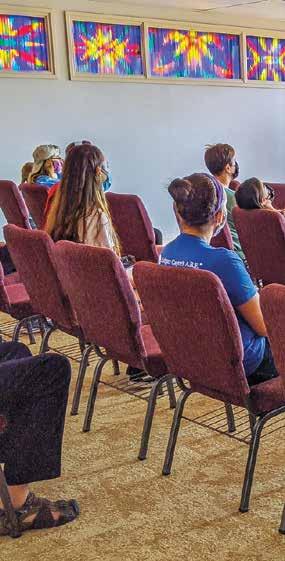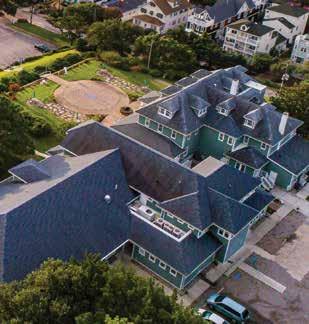
7 minute read
Wellness and Enlightenment in Virginia Beach
By Dave Bodle
For more than 90 years, Edgar Cayce’s A.R.E. has been helping people transform their lives through profound personal change of mind, body and spirit. Cayce was known as the “father of holistic medicine” and the most documented psychic of the 20th century.
Born 1877 on a farm in Hopkinsville, Kentucky, Cayce’s psychic abilities appeared in his childhood with an uncanny ability to memorize pages of books by sleeping on them. Later in life, Cayce had the ability to place himself in a state of relaxation and meditation with his mind in contact with all time and space. In this state of a super-conscious mind, he was able to answer broad and specific questions. The responses to these questions became known as “readings.”
You’re likely surprised that Cayce was a regular with his church attendance and a Sunday school teacher. In his youth, he vowed to read the Bible every year of his life. He passed in 1945 having accomplished that promise made to himself. Once asked how to become a psychic, Cayce advised to become more spiritual.
Cayce’s first readings began in Dayton, Ohio during the late 1920s. By 1931, he had told himself to move to the sea. He chose Virginia Beach and founded A.R.E. The greater part of the early readings dealt with holistic health and the treatment of illness. One hundred years later, individuals continue to receive relief from ailments through the information provided in those readings. A favorite is his reading that a virus cannot live in an alkaline environment. Orange juice is the key to an effective alkaline acidic balance.
While in his self-induced sleep, Cayce did not seem to focus only on the body and physical pains. In their entirety, the readings show 10,000 wide-ranging topics with vast subject matter. When narrowed down, the readings seem to fall into five categories, 1. Health Related Information, 2. Philosophy and Reincarnation, 3. Dreams and Dream Interpretation, 4. ESP and Psychic Phenomena, 5. Spiritual Growth, Meditation and Prayer.
Edgar Cayce’s A.R.E. is a nonprofit supported through its membership. In an excerpt from a 1938 Edgar Cayce letter, “The A.R.E. is not a creed, cult or doctrine. It is merely a name used to designate a group of people joined together with a certain common attitude toward the field of religion, philosophy, science and life. Its central drive is the attempt to apply all knowledge to the problem of better living.”
VISITING THE A.R.E. HEADQUARTERS CAMPUS IN VIRGINIA BEACH
Every year, the A.R.E. Headquarters campus attracts more than 100,000 individuals from around the world, including vacationers and group tours. Built in 1975, the Visitor Center houses the library, meditation room, bookstore and gift shop. The A.R.E. Health Center & Spa is located in Cayce’s historic hospital building, along with Cayce/Miller Café featuring Graze Kitchen and Catering.
The library is the jewel of Edgar Cayce’s legacy and stands as a memorial to his life and work. More than 14,000 readings are on display. The famous

Aerial view of A.R.E. campus

Meditation room

couch where Cayce self-induced his sleep is on display along with the desk his secretary, Gladys Davis, used to transcribe the readings. The original reading was given to the person requesting the reading, while a carbon copy was preserved.
The library also contains 80,000 volumes specializing in the fields of metaphysics, parapsychology, comparative religious studies, holistic health, ancient civilizations and foreign language editions of Edgar Cayce books. Many of the books in the collection are difficult to find elsewhere.
On the third floor of the Visitor Center is the Meditation Room, accessible by elevator and overlooking the Atlantic Ocean. Meditation was an important part of the Cayce concept. The diverse artwork embraces all of the world’s religions. The stained-glass windows were donated by Fredrica Fields. She was given a reading as a wedding gift, but did not open it for 45 years. Impressed by the reading that she would become involved in stained prisms and glass, she chose to make the donation. By this point in her life she was a famous and accomplished stained-glass artist. The Meditation Room is available for use at any time the building is open. Visitors are welcome to join a weekday noon-time meditation.
The A.R.E. Bookstore & Gift Shop provides a variety of books and products for those interested in Edgar Cayce’s readings. Among the offerings are Cayce healthcare products, unique jewelry, gemstones, candles and incense and much more. The Harris Prayer and Meditation Garden located on the side of the Visitor Center features a wooden stairway leading to
Library
a peaceful garden with stone walkways, a waterfall and relaxing benches.
The A.R.E. Health Center & Spa has a fascinating history. Opening in 1929, the historic landmark originally named “The Cayce Hospital for Research and Enlightenment” was Cayce’s dream to help others with the holistic health information from his readings. Suffering through the Great Depression the hospital was eventually lost. The building was repurchased by A.R.E. and opened in 1967 and renovated in 2014.
Today, the A.R.E. Health Center & Spa continues to focus on holistic healing through massage therapy,
bodywork, hydrotherapies, acupuncture and chiropractic care. All are found in the Edgar Cayce readings supporting the body’s innate healing abilities. Spa Packages and Rates can be found online atedgarcayce.org/are-health-centerspa/spa. Or call to book an appointment at 757-457-7202. floor of the Cayce Hospital Building sharing space with the lobby of the A.R.E. Health Center & Spa.
Groups are welcome on the campus. Regular and pre-arranged tours of the Visitor Center and films are available at no cost. Telephone 800-333-4499 or begin planning online at edgarcayce.org. 1
A.R.E.’s Cayce/Miller Café features Graze Kitchen & Catering under the proprietorship of Chef Shelley Kilby, winner of Food & Wine Magazine’s, “Best New Chefs in America” 2003. Seasonal menus prepared with fresh, locally sourced ingredients are Chef Kilby’s passion. The Café is located on the main
THIRD VIRGINIA LOCATION DESIGNATED AS A CIVIL RIGHTS SITE
By Dave Bodle
Photo courtesy of Danville Museum of Fine Arts & History

Danville Museum of Fine Arts & History offers three fine art galleries, historic period art, Civil War exhibits, as well as the Sutherlin Mansion.
The sites are places where activists challenged segregation and inequality in the 1950s and 1960s to advance social justice. Danville is one of three locations in Virginia. The other sites are in Richmond and Farmville. The U.S. Civil Rights Trail encompasses more than 120 sites, primarily in the South.
“Danville played a critical role in the civil rights movement, so we are extremely proud to be added to the U.S. Civil Rights Trail,” said Elsabe Dixon, the museum’s executive director. “Inclusion and diversity are cornerstones of the Danville museum’s experience. We invite everyone to visit the museum and discover the many remarkable stories.”
In August 2019, the museum installed the first long-term civil rights timeline available to the public. The Movement: Danville’s Civil Rights is an exhibition that details the events that took place in Danville during the 1960s, the work done by the Southern Christian Leadership Conference in 1958 to establish support for Martin Luther King’s visits to Danville. It also outlines the role of Sutherlin Mansion and then the Danville Public Library, a “whites only” library in 1960.
The museum also features the Camilia Williams exhibition, which highlights the relationship this New York City Opera diva had with her hometown, Danville.
Mayor Alonzo Jones in a letter of support for the application, stated, “Danville has made great strides and I am excited about our future, but we must not forget that our city’s heritage is also rich with struggle – a struggle that I believe is significant to the civil rights movement.”
U.S. Civil Rights Trail sites must: Be associated with events that made a significant contribution to the civil rights movement during its height; 1950s and 1960s. Or, has been associated with the life of a person(s) who was significant in the civil rights movement. Or, embody the distinctive characteristics of a tourism site, including but not limited to being open to the public, or public view as a tourist attraction, providing guided or selfguided experiential activities, or displaying a series of commemorative markers that communicate context for the history of the civil rights movement. The museum applied summer of 2021 for inclusion as a site on the trail.
For more information about the museum and its exhibits, visit online at DanvilleMuseum.org.


Explore the world’s largest living history museum. Take a tour. Enjoy an interactive evening program. Dine at an 18th-century tavern. Visit our two world-class art museums. Relax and play at our award-winning spa, golf club, tennis club, and four pools. At the end of the day, retire to one of our five hotels, just steps away from the Historic Area. At Colonial Williamsburg, spending time together has never been easier.





